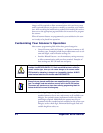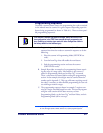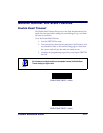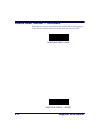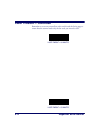
3URGXFW5HIHUHQFH*XLGH 6-7
3URJUDPPLQJ6HTXHQFH
To modify a scanner feature (item), the programming bar codes contained
in this manual must be scanned in a given sequence depending upon the
feature being programmed (as shown in Table 6-1). There are three possi-
ble programming sequences:
A. Programming sample A (the most commonly used format) dem-
onstrates how three bar codes are scanned in sequence to do the
following:
1. Place the scanner in Programming Mode (SWITCH bar
code).
2. Scan the Item Tag
1
that will enable the new feature.
3. End the programming session and reset the scanner
(SWITCH bar code).
B. Sample B provides an example of a programming feature requir-
ing the entry of a range value. Like sample A, the scanner is
placed in Programming Mode and an Item Tag
1
is scanned.
Then, a value must be entered before ending the programming
session. In the example, three digits must be scanned from the
number pad in Appendix C. This type of format, requiring several
bar codes, is necessary to allow flexible programming for item val-
ues with larger numeric ranges.
C. The programming sequence shown in example C requires scan-
ning of a single, extended length bar code. This special program-
ming bar code contains all the data necessary to enter
Programming Mode, set the Item Tag
1
and Item Value, and exit
Programming Mode (all in one step).
NOTE
If the scanner’s interface type must be changed, always be sure that inter-
face configuration is the FIRST item scanned during a programming ses-
sion. (Selecting an interface type resets ALL other configuration items to
the factory default for that interface type.)
1. An “Item Tag” is a term used to describe an assigned number, which is encoded in a programming
bar code, that toggles (selects, enables, disables, etc.) a specific programming feature.






